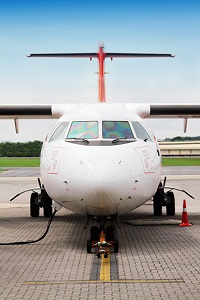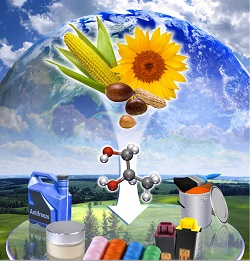
Meeting the Catalysis Challenge in Aviation Fuels
by John Holladay

While aviation only accounts for about 2 percent of our energy use, it has received lots of attention for its contributions to greenhouse gas—3 percent of global anthropogenic CO2 emissions and 2-14 percent of anthropogenic induced warming from the co-emission of NOX SO2 and black carbon and formation of aircraft vapor trails. Over the years the aviation industry has made great strides in improving energy efficiency. Today's jet aircraft are greater than 70 percent more fuel-efficient than early jets of the 1960s, like the Comet 4, and can average as high as 100 passenger miles per gallon. To reduce greenhouse gases further, there are additional strides in efficiency to be made, but at the same time we are working with industry to provide alternative, low-carbon, renewable fuels that can be used in commercial aviation. Read more.
Catalysis Process for Producing Propylene Glycol Recognized
PNNL and partner Archer Daniels Midland among five finalists for Kirkpatrick Award
 When you combine unique catalysis capabilities with solid R&D expertise, excellent industrial contacts, and plenty of hard work, great things happen. Take, for example, the team of Pacific Northwest National Laboratory (PNNL) chemical engineers and scientists who developed propylene glycol from renewable sources (PGRS), a catalytic process that offers an environmentally friendly, commercially viable method for converting plant-based, seed-oil-derived glycerol, sugars, or sugar alcohols to propylene glycol. Read more.
When you combine unique catalysis capabilities with solid R&D expertise, excellent industrial contacts, and plenty of hard work, great things happen. Take, for example, the team of Pacific Northwest National Laboratory (PNNL) chemical engineers and scientists who developed propylene glycol from renewable sources (PGRS), a catalytic process that offers an environmentally friendly, commercially viable method for converting plant-based, seed-oil-derived glycerol, sugars, or sugar alcohols to propylene glycol. Read more.
90 Seconds of Discovery:
Frustrated Lewis Pairs research combines theory and experiment
 From biofuels to ammonia, a variety of valuable chemicals depend on the efficient catalytic activation of hydrogen. At PNNL, we want to contribute to the development of the next generation of efficient hydrogen-activating catalysts. Our approach is to better understand how these reactions work and then control their environment. Enter frustrated Lewis pairs. Conventional wisdom says only metals can activate hydrogen, and non-metals such as Lewis pairs should not. But they do, and nobody really knows why. Watch the video.
From biofuels to ammonia, a variety of valuable chemicals depend on the efficient catalytic activation of hydrogen. At PNNL, we want to contribute to the development of the next generation of efficient hydrogen-activating catalysts. Our approach is to better understand how these reactions work and then control their environment. Enter frustrated Lewis pairs. Conventional wisdom says only metals can activate hydrogen, and non-metals such as Lewis pairs should not. But they do, and nobody really knows why. Watch the video.
February 2014
Catalysis News & Research:
Morris Bullock writes Science perspective. In an invited opinion piece, Bullock discusses advances in using iron and other earth-abundant metals for catalysts in organic synthesis and other applications. Read more.
Ilke Arslan invited to the 25th U.S. Kavli Frontiers of Science Symposium. At this invitation-only National Academy of Sciences event, Arslan shared research and discussed new ideas and old theories with other high-profile young scientists across a wide range of disciplines. Only 90 scientists under the age of 45 were asked to attend. Read more.
James White wins prestigious award. A former IIC member, White won the 2014 Paul N. Rylander Award for his exceptional contributions to the use of catalysis in organic reactions. Read more.
When less is more: Fewer proton relays improve catalytic rates. The first direct comparison of three closely related catalysts established that hydrogen production speed and efficiency are influenced by the molecules' structure and proton relay arrangement, not the total number relays. Catalysts with just two relays outperformed those with 4. Read more.
Fast nickel catalyst breaks into college textbook. Congratulations to the team at the Center for Molecular Electrocatalysis, who had their nickel-based catalyst discussed in Inorganic Chemistry, a popular undergraduate text. Read more.
If you have feedback – ideas, suggestions or questions – about IIC's Transformations, please contact Julie Wiley.